
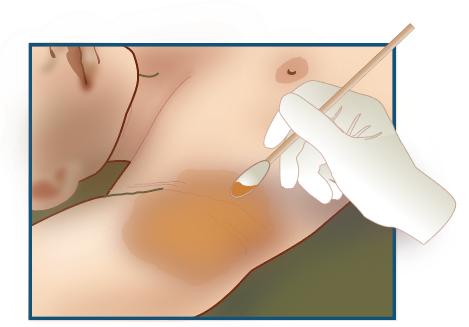
Patient Preparation: Mapping the Hyperhidrotic Area with Minor’s Starch-Iodine Test
1. Clean and dry the axilla thoroughly and completely.
2. Paint the entire underarm area with an iodine solution or povidone-iodine, or with pre-moistened Betadine® swabs or swabsticks.
3. Allow the solution to dry. This will take a few seconds to approximately 1 minute.
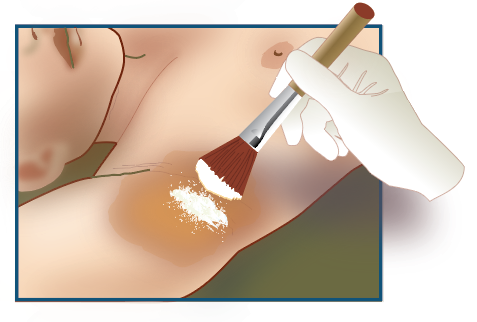
4. Dust the entire site evenly and very lightly with fine starch powder. Any commercially available cornstarch will suffice.
5. Wipe off any excess.

6. The presence of sweat will cause the mixture to turn a dark blue-purple color, making the location of sweating discernible. Wait approximately 10 to 15 minutes for the reaction to occur.
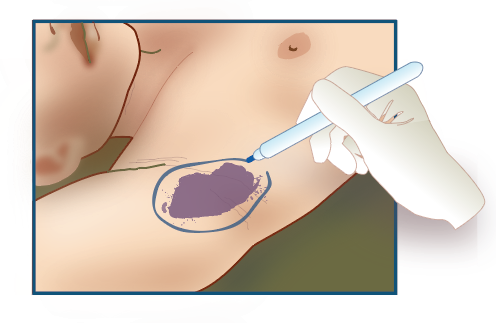
7. Outline or circle the area of excessive sweating with a surgical marker, or dermographic pen. The area may appear as one circle or oval, or it may appear as multiple areas, like “islands”.
8. Clean off excess starch and iodine solution.
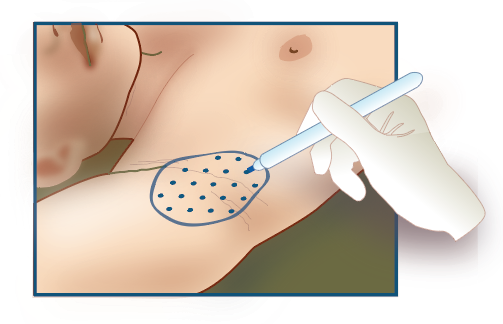
9. Use a surgical marker, or dermographic pen to identify locations within the sweating area that are 1.5 cm apart from one another. The sites should be positioned in a staggered manner rather than linear. Because onabotulinumtoxinA diffuses under the skin to a diameter of approximately 2 cm, it is recommended that physicians administer the injections at sites 1.5 cm apart in order to provide uninterrupted coverage and treatment of the area. This technique helps to limit any area of no effect.
10. Prep the area with antimicrobial solution.
Reconstitution and Dosing of onabotulinumtoxinA
OnabotulinumtoxinA (BOTOX, AbbVie, Inc.; 100u per vial) is supplied vacuum-dried and purified. Reconstitution is required. Based on clinical research, the recommended dose is 50 u/axilla.
1. Each 100u vial of onabotulinumtoxinA should be reconstituted with 4 mL of sterile 0.9% non-preserved saline solution (50 U-2 mL).
2. The total injection volume (4 mL) is then drawn into 4 separate 1 mL syringes with a 20 to 22-guage needle.
3. To minimize patient discomfort, the needle should then be replaced with a higher gauge (e.g. 30-guage) needle for injection.

4. OnabotulinumtoxinA is administered via an intradermal injection. The onabotulinumtoxinA will diffuse under the skin in a ring of approximately 2 cm in diameter and points of injection should be evenly spaced 1.5 cm apart and demarcated before proceeding. Twelve to 15 injection sites are typical. The clinician will need to divide 50 units evenly among the injection sites, per axilla.
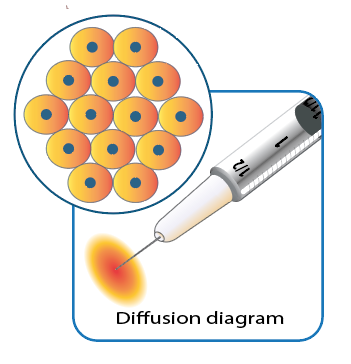
5. OnabotulinumtoxinA is injected slowly and carefully into the intradermal plane of each axilla. A 10- to 30-degree angle should be used to enter the skin. Continue to maintain this angle and slowly inject an aliquot of the reconstituted onabotulinumtoxinA into the dermis of the skin. Avoid puncturing the skin exactly at the ink dot of your surgical marker because it may be possible to carry some of the ink into the skin and leave a permanent mark.
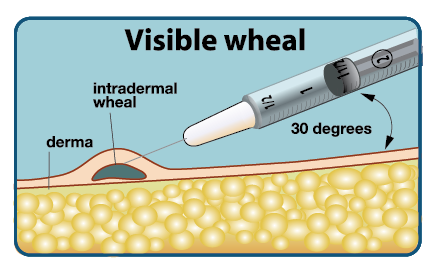
6. Physicians should try to obtain a visible wheal that confirms the placement of the drug in the proper plane of the skin. Continue administration/injection until each marked site of each axilla has received the proper amount of drug.
7. Hold compression to facilitate hemostasis.
8. Wipe off surgical markings.
9. Monitor patient for adverse effects or allergic reaction.
Patient Assessment and Follow-Up
Patients can expect results in approximately one week. Based on clinical trials, successful treatment with onabotulinumtoxinA provided relief from excessive sweating of the axilla for approximately 7 months. Studies have found that 25% of the patients may experience relief for up to 12 months. Patients should return to their clinician for repeat treatments once the hyperhidrosis symptoms reemerge. If after two weeks, excessive sweating persists, it is possible that some areas of sweating were missed during the initial administration, or an injection may have been placed in the wrong plane of the skin. If this occurs, patients should see their medical professional. Additional injections may be necessary to complete the treatment, as follows.
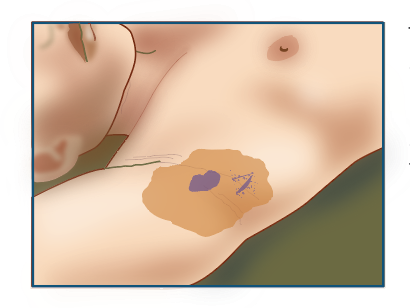
The axilla should be re-mapped using Minor’s starch-iodine test. The starch-iodine test will help the clinician determine where on the skin persistent excessive sweating is occurring. Follow proper Patient Preparation, Reconstitution, and Administration protocol to administer a few units (approximately 2-5u per site) of onabotulinumtoxinA to the affected areas.


